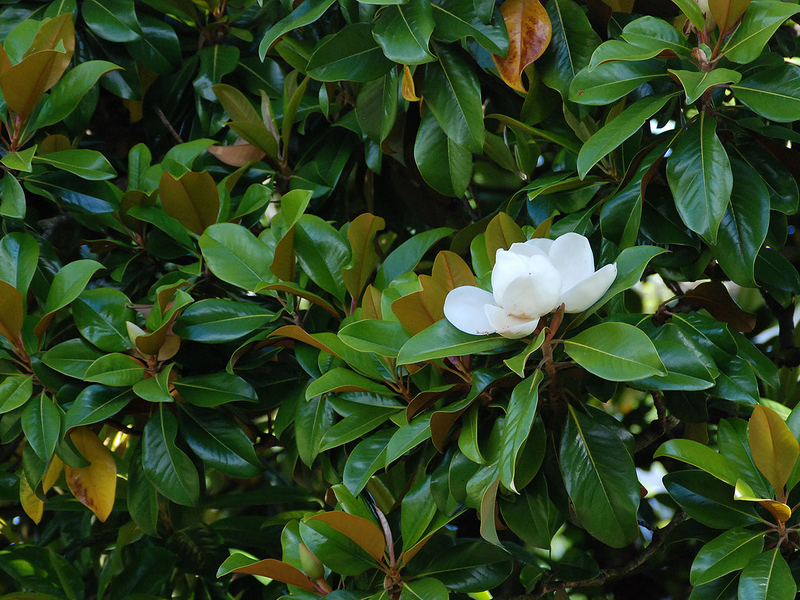Southern Magnolia
Magnolia grandiflora
Click here to download a PDF of this plant information page (for printing).

Sun Exposure: Full Sun, Part Sun
Season of Interest: Spring, Summer, Fall, Winter
Bloom Time: April - May
Bloom Color: White
Height: 60 to 80 ft.
Spread: 30 to 50 ft.
Spacing: 50 ft.
Water Needs: Average
Maintenance: Very little
Soil Type: Any
Soil pH: Acidic, Neutral
Soil Drainage: Well drained
Pests: None
Diseases: None
Wildlife: Birds and small mamals

Description:
Southern magnolia, is a large, broadleaf evergreen tree that is noted for its attractive glossy dark green leaves and its large, extremely fragrant flowers. It is native to the bottomlands and moist wooded areas in the southeastern Us. It typically grows to 60 to 80 feet tall with a pyramidal to rounded crown, a spread of 20 to 40 feet wide, and a trunk diameter of 3 feet. It is a member of the magnolia family (Magnoliaceae). This is a magnificent tree for planting as a specimen in the South in large yards, parks, or commercial sites. Be sure to provide plenty of space to grow. Lower branches tend to reach the ground and can be pruned out to appear more tree-like. Nothing will grow underneath the tree, and it requires a mulch to prevent erosion problems. Giant fragrant white flowers are borne in the summer months and are extremely ornamental. It prefers rich soil with partial shade and, in nature, is usually an understory tree. However, when grown as an ornamental, it maintains heavily leaved limbs almost to the ground. Tolerates high moisture levels, but is intolerant to overly wet or swampy soils and prolonged flooding. For more information see:
plants.ces.ncsu.edu/plants/magnolia-grandiflora
Care and Growing Tips:
Southern Magnolias do best in partial shade, particularly if soil conditions aren't all that moist. Once established, they can do well in a full sun position in moist, rich soils. Ideally, your tree should receive at least four hours of unfiltered sunlight a day. In nature, southern magnolia is an understory tree, so it tolerates shade, although it needs sun to bloom well. These trees do best in moist, well-drained, loamy, acidic, and fertile soils. However, they can tolerate a wide range of conditions and pH levels. Overly dry or prolonged waterlogged conditions and high alkalinity aren't appreciated. Providing your southern magnolia has ample room for root expansion and the soil is not a poor, dry type, it will demonstrate drought tolerance. When first planted, the tree will need weekly watering to become established. Once established, water frequency will depend on soil drainage and regional rainfall. Too much or too little water can cause the tree's leaves to turn yellow. Mulching around the planting area is beneficial—just avoid allowing the mulch to touch the tree's trunk. Fertilizing three times a year—in spring, summer, and fall—is beneficial once your southern magnolia starts to produce new growth. By the fourth or fifth year, unless your tree is in particularly infertile soil, its sprawling roots should be able to find sufficient nutrients themselves.